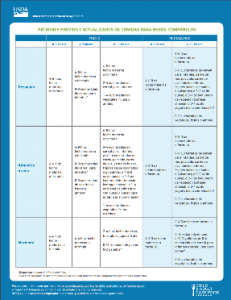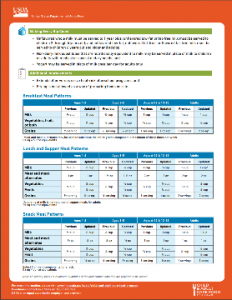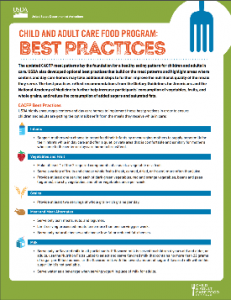How can the meal in the CACFP be served?
Traditional Child Care Centers:
Only the meal types specified in the center’s agreement that are served in compliance with the meal pattern requirements may be claimed for reimbursement. The center may choose from the following meal types:
- Breakfast,
- Morning snack,
- Lunch,
- Afternoon snack, and
- Supper
Centers may be approved to claim for reimbursement, a daily maximum of two meals (breakfast and/or lunch and/or supper) and one supplement (snack), or two snacks and one meal, to each enrolled participant in attendance. The meals/snacks must meet or exceed the meal pattern requirements. The center can select and implement the meal service styles or methods of preparation best suited to the needs of the center and enrolled children [7 CFR 226.17(b)(3) and (4)].
Outside-School Hours-Care Centers
OSHCCs may be approved to claim one or more of the following meal types: breakfast, snack, or supper. A maximum of two meals and one snack or two snacks and one meal may be claimed daily for each child. In addition, such centers may be approved to serve lunch to enrolled school-age children during periods of school vacation, including weekends and holidays, and to enrolled children attending schools which do not offer the National School Lunch Program (NSLP). Such centers, however, cannot be approved to operate the CACFP on weekends only [7 CFR 226.17(b)(5)].
Emergency Shelters
Emergency shelters may be approved to claim up to three reimbursable meals – breakfast, lunch, and supper, or two meals and one snack – to each child, each day, on weekdays and weekends. Only meals served in congregate meal settings are eligible for reimbursement. Meals which are consumed in private family quarters in an emergency shelter are not reimbursable.
Types of Meal Service:
Unitized Meals:
All food components (menu items) of the meal or snack must be served to each child all at the same time.
Cafeteria Style Meal Service
Family Style Meal Service:
Family Style is a type of meal service which allows children and adults to serve themselves from common platters of food with the assistance of supervising adults. Institutions and facilities choosing to exercise this option must be in compliance with the following practices:
- A sufficient amount of prepared food must be placed on each table to provide the full required portions of each of the components, as outlined in the CACFP meal pattern requirements, for all children or adults at the table and to accommodate supervising adults if they wish to eat with the children and adults.
- Children and adults must be allowed to serve the food components themselves, with the exception of fluids (such as milk). During the course of the meal, it is the responsibility of the supervising adults to actively encourage each child and adult to serve themselves the full required portion of each food component of the meal pattern. Supervising adults who choose to serve the fluids directly to the children or adults must serve the required minimum quantity to each child or adult.
Offer vs. Serve (OVS):
The CACFP OVS requirements support the practice of offering a variety of food choices for adults, increase the likelihood that adults will select foods they prefer, reduce waste, and ensure adults are receiving enough food to meet their nutritional needs. All sponsors and independent centers electing to use OVS in the adult day care settings of the CACFP are required to follow the CACFP OVS requirements. The OVS requirements in the CACFP are as follows:
OVS at Breakfast
The CACFP breakfast meal pattern requires three food components to be offered: milk, fruits and vegetables, and grains. As a reminder, fruit and vegetables are one combined component in the breakfast meal patterns. When using OVS at breakfast, at least the following four food items, in the required minimum serving sizes, must be offered:
- A serving of milk;
- A food item from the fruit and vegetable component;
- A food item from the grains component; and
- A food item from the meat/meat alternate component or one additional item from the fruit and vegetable component or grains component.
- OVS must be noted in the site application and approved by the State agency prior to administering in the center
- Quick OVS Guide
OVS at Lunch or Supper
The CACFP lunch and supper meal patterns requires all five food components to be offered: milk, meat/meat alternates, vegetables, fruits, and grains. Milk is optional for supper meals served in the adult day care centers.
When using OVS at lunch or supper, at least one food item from each of the five food components, in the required minimum serving sizes, required at lunch and supper must be offered:
- A food item from the meat/meat alternate component;
- A food item from the vegetable component;
- A food item from the fruit component; and
- A food item from the grains component
*As noted above, milk is optional for supper for meals served in adult day care centers and does not need to be offered when serving an OVS supper in those settings. In all other situations, milk must be offered.
Meal Preparation System:
The best system of meal preparation in a given situation will depend upon such factors as the type of menu desired, the availability of food service equipment, space and personnel, and the budget of the organization. The following list includes the several types of food service systems available to centers.
- Onsite:
Onsite preparation is the most commonly used food service system. The meals are prepared at the same location where they are to be served. This is usually the most economical method when the center has a kitchen, sufficient food preparation equipment, and available staff. All or part of the food may be prepared onsite and the remainder purchased by the institution from an outside source, such as a school, hospital, or commercial vendor or farmers market. The FNS Instruction 796-2, Rev. 4 provides guidance for funding food grown by and used in the child care center’s meals. This option offers education opportunities and may decrease food costs.
- Purchasing from a School:
Meals may be purchased from a school that participates in the National School Lunch Program, either in bulk or as individual packaged units. An independent center that receives meals from a school must enter into a written agreement with that school. This agreement must contain the basic provisions of the Program requirements. Signing an agreement with a school to provide meals does not relieve the independent center of its Program responsibilities for monitoring and recordkeeping. The school should provide a copy of the menus served and meal service records required by the State agency [7 CFR 226.19a(b)(7)].
- Purchasing From a Food Service Management Company:
Food service management companies are organizations that prepare and deliver meals. An independent center that purchases meals from a food service management company must enter into a written contract with the company. The State agency can provide a copy of the standard contract that must be used and guidance on meeting procurement standards. Signing a contract with a food service management company does not relieve the center of its Program responsibilities for monitoring and recordkeeping. Regulations require that a copy of the contract be submitted to the State agency before the beginning of Program operations under the contract; and all bids totaling $50,000 or more shall be submitted to the State agency for State agency approval before the institution accepts and signs any contract. In additional, all bids shall be submitted to the State agency for approval before accepting a bid which exceeds the lowest bid. State agencies shall respond to any request for approval within 10 working days of receipt [7 CFR 226.21(a) and (c)].
- Purchasing from a Commercial Vendor:
Commercial vendors are public organizations (hospitals, college cafeterias, etc.), private commercial enterprises, or individuals that provide nonfood items or individual food items but not complete meals. An independent center that purchases from a commercial vendor must enter into a written contract with the vendor. The State agency can provide a copy of the standard contract and additional guidance on meeting procurement standards.
CACFP Meal Pattern:
The updated meal standards for the CACFP were published in the Federal Register on Monday, April 25, 2016. CACFP centers and day care homes were required to comply with the updated meal standards by October 1, 2017.
Regulations:
- Child and Adult Care Food Program: Meal Pattern Revisions to the Healthy, Hunger-Free Kids Act of 2010, Final Rule
- Crediting Handbook
- Feeding Infants in the CACFP
- Press Release

|

|

|
CACFP Meal Pattern Documentation:
- Special Dietary Prescription Form
- Infant Formula Choice Form
- Sample Menu
- Crediting handbook
- Food Buying Guide
Updated USDA Meal Pattern Resources:
Halftime Thirty on Thursdays: Recorded Webinars / Training Tools
Recorded Webinar Series:
- Grains
- Grain-Based Desserts in the CACFP
- Grains Ounce Equivalents
- Crediting Single-Serving Packages of Grains in the CACFP
- In-Grained: Easy Tools to Determine Serving Amounts
- Whole Grain Rich
- Adding Whole Grains to Your CACFP Menu
- Identifying Whole Grain-Rich Foods for the CACFP Using the Ingredient List, Part 1
- Identifying Whole Grain-Rich Foods in the CACFP, Part 2
- Using the WIC Food List to Identify Creditable Foods in the CACFP
- Infants
- Crediting Store-Bought Combination Baby Foods in the CACFP
- Feeding Infants: 0-5 months
- Feeding Infants: Starting with Solids
- How to Support Breastfeeding in the CACFP
- Meal Service and Menu Planning
- Meal Planning for the CACFP
- Methods for Healthy Cooking
- Offer Versus Serve in the CACFP
- Using the Nutrition Facts Label in the CACFP
- Mealtimes with Toddlers
- Mealtimes with Toddlers
- Meats/Meat Alternates
- Serving Meat and Meat Alternates at Breakfast
- Milk
- Serving Milk in the CACFP
- Sugar Limits
- Choose Breakfast Cereals That Are Lower in Added Sugars
- Choose Yogurts That Are Lower in Added Sugar
- Vegetables
- Serving Vegetables in the CACFP
- Chooses Breakfast Cereals That Are Lower in Added Sugars
- Choose Yogurts That Are Lower in Added Sugars
- Serving Milk in the CACFP
- Meal Planning in the CACFP
- Serving Meat and Meat Alternates at Breakfast
- Offer Versus Serve in the CACFP (Applicable only to Adult Day Care Centers)
- Methods for Healthy Cooking
- Adding Whole Grains to Your Menu
- Feeding Infants: 0-5
- How to Support Breastfeeding
- Feeding Infants: Starting with Solids
- Identifying Whole Grain-Rich Foods for the CACFP Using the Ingredient List
- Grain-Based Desserts in the CACFP
Growing a Healthier Future With the CACFP Infographic
Nibbles For Health: Nutrition Newsletters for Parents of Young Children
Institute of Child Nutrition:
National CACFP Sponsors Association Meal Pattern Resources:
